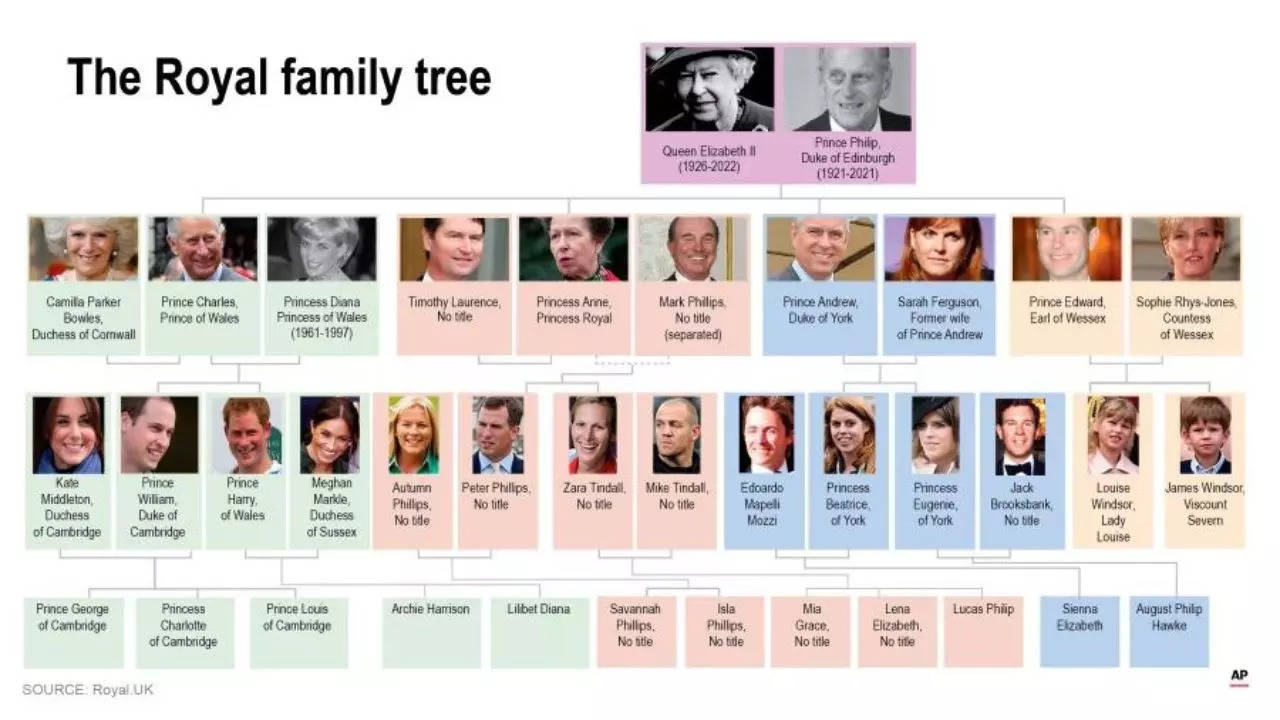Operation Unicorn: the plan for Queen's death in Scotland, originally codenamed 'London Bridge'
Queen Elizabeth II, the longest reigning British monarch (70 years), passed away at 96 in London, paving the way for her first-born Prince Charles to become the King and a long-planned "Operation London Bridge" goes underway in the British Isles. The national anthem immediately shifted back to "God Save the King". The UK authorities had devised Operation London Bridge to manage events during the first 10 days between the Queen's death and the funeral. They had thought of Operation Unicorn in case the queen died in Scotland. She passed away in Balmoral, Scotland on September 8.

The Royal family tree following Queen Elizabeth
Photo : AP
It is no secret that the UK's plan for the eventual death of Queen Elizabeth II was codenamed London Bridge.
But there were special provisions if the monarch died when she was in Scotland, called Operation Unicorn.
The unicorn is the national animal of Scotland and forms part of the royal coat of arms, along with the lion of England.
The 96-year-old monarch passed away at her remote Highlands residence, Balmoral, with all her immediate family flying in to be at her side.
Her death set in motion Operation London Bridge, plans for services and succession that have been put in place since the 1960s and revised regularly over decades.
Details about the plan have been revealed over the years, shedding light on how the planned 10 days between the queen’s death and her funeral will truly look.
As per the documents seen by The Politico, Thursday will be declared as "D-Day" and each following day leading up to the funeral will be referred to as "D+1," "D+2" till the tenth of her death.
As per one official memo, the code for conveying the message of the Queen's death is "London bridge is down." What will follow is a vast security operation to manage crowds and travel chaos, the report said.
Aspects of Operation London Bridge were already activated such as BBC presenters wearing black and channels switching to rolling news.
The Herald newspaper reported that the term Operation Unicorn was first used in the Edinburgh parliament's online papers in 2017, envisaging huge numbers arriving in Scotland if that was where the monarch died.
"It is understood that if the Queen dies in Scotland... the Parliament, the neighbouring Palace of Holyroodhouse, and St Giles' Cathedral will be the main focal points," the newspaper wrote Wednesday.
The palace is the monarch's official residence in Edinburgh, and the cathedral is one of the Scottish capital's most important medieval churches.
Parliamentary business will be immediately suspended and politicians will prepare a motion of condolence and get ready for a state funeral.
Members of the public will sign a book of condolence at the parliament at Holyrood.
A source in the parliament told The Herald that the Queen's death in Scotland could result in hundreds of thousands of people arriving there.
"If the Queen passes away in Scotland, her body will rest at Holyroodhouse, following which her coffin will be carried to the cathedral on the Royal Mile (in Edinburgh)," the newspaper wrote.
Her body will then be placed on the Royal Train at Waverley station in Edinburgh for a journey down the east coast mainline to London.
Ten days after Queen's death, the newly appointed UK Prime Minister Liz Truss will be the first member of the government to make a statement.
Aside from the statement from the PM and other members of the government, gun salutes will be arranged at all saluting stations.
Subsequently, Liz Truss will hold an audience with the new king, and King Charles will deliver a broadcast to the nation.
The state funeral will be held at Westminster Abbey and there will be a committal service in St. George's Chapel at Windsor Castle.
Thereafter, Queen Elizabeth II will be buried in the castle's King George VI Memorial Chapel.
(Inputs from AFP)
Trending:
End of Article
Subscribe to our daily Newsletter!
Related News





Loch Ness Monster Spotted In Canada? Truth About British Couple's Viral Video

From Kelli Ward To Greg Safsten: 11 Trump Allies Charged In 2020 Arizona Elections Case | Full List

New Smyrna Beach: No Explosion In Florida, Locals See Fire And Smoke

Gov Greg Abbott Slams Protests At University Of Texas, Austin: 'Belong In Jail

US 'Secretly' Shipped Long-Range Missiles To Ukraine In Recent Weeks









